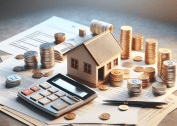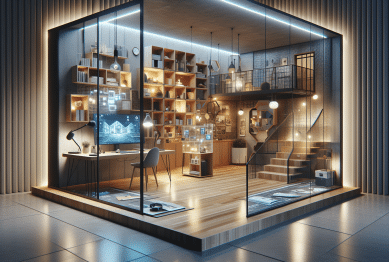Ever wondered what really influences property prices? This guide unpacks the secret elements shaping home values, neighborhood desirability, and resale potential. Learn how location, schools, and smart upgrades can affect a property’s worth and help buyers and sellers make informed decisions in any real estate market.
Location Beyond the Obvious: What Drives Desirability?
When most people think of home value, location comes first. Yet, it’s not just about being close to a city center or popular area. Real estate value often depends on more nuanced markers such as proximity to public transit, park access, and even the vibe of the neighborhood streets. For example, a home near a quiet green space may see stronger appreciation than one on a busy intersection. Local retail development and safety statistics also help boost perceived value in ways that sometimes get overlooked by buyers focusing solely on headline amenities. By considering these subtler elements, prospective homeowners and investors alike may spot untapped growth potential.
Research reveals that even small differences in walkability can impact property prices more than distance to downtown. In some cases, blocks or neighborhoods with high walk scores command premium prices. Attractive landscaping, local businesses, and community events tend to raise a neighborhood’s profile. These add-ons create an environment that draws people in and, over time, increases overall demand. Simple factors like well-maintained sidewalks or tree-lined streets can become tiebreakers for buyers weighing similar homes in different areas.
Transportation really matters—often even more than buyers initially realize. Access to bus lines, subway stations, or commuter rails plays a major role for residents who prioritize easy commutes. As new transit projects are completed, formerly overlooked neighborhoods may experience strong jumps in value. Those searching for homes might benefit from looking at upcoming infrastructure projects. When paired with established schools and low crime rates, these elements form a potent mix for long-term appreciation. Explore local government planning documents for insights into potential growth zones.
School Zones and Value: Not Just for Families
School quality is a powerful driver of home prices, and not just for buyers with school-age children. Homes within highly rated school district boundaries consistently sell at a premium, often regardless of property style or even size. Many buyers see access to good schools as a core investment in future resale potential. In competitive markets, even modest homes can attract bidding wars just because they fall within top-ranked zones. The School District boundary line itself plays a surprising role in shaping prices, leading to abrupt jumps in value from one block to the next.
Interestingly, renters and investors also weigh school ratings. Even those not planning to use local public education see high-performing districts as an indicator of stable or rising demand. Rental properties in these areas may fetch higher rents and attract longer-term occupants. On a broader level, studies show a positive correlation between school performance and neighborhood safety, community amenities, and public investment—elements all valued by house hunters. Using publicly available ratings and online maps can help buyers who want to research the impact before making an offer.
The draw of high-ranked schools extends into overall neighborhood culture. Families may move in before their children are even born, planning ahead for future needs. Good schools also tend to attract local businesses and services designed to cater to families, further raising the area’s desirability. Even if schools don’t directly shape a decision, savvy buyers should factor educational quality into their price calculations. For some, the ‘school lines effect’ can be just as meaningful as square footage or lot size when determining a property’s potential value over time.
Smart Upgrades That Boost Resale Return
Upgrading a home can yield outsized returns, but not every renovation leads to higher resale value. Features like energy-efficient windows, updated kitchens, and remodeled bathrooms are consistently popular with buyers. However, it’s important to weigh cost versus expected value. Simple changes, like repainting in neutral tones or enhancing curb appeal with landscaping, often provide strong returns for a fraction of the price of major renovations. Data from national realtor associations highlights that minor updates in appearance and energy improvements frequently outperform luxury add-ons when it comes to resale growth.
According to several homeowner studies (see sources below), renovations that raise a property’s efficiency—insulation, new HVAC, solar panels—have become more desirable. These upgrades reduce ongoing costs and highlight the home’s sustainability features. As society becomes increasingly eco-conscious, more buyers are prioritizing green additions even over traditional luxury features. Before investing in major remodels, experts recommend consulting with real estate agents or appraisers who understand what’s trending locally.
Another area driving higher sale prices is smart home technology. From Wi-Fi-enabled thermostats to integrated security systems, these features are rapidly moving from ‘nice-to-have’ to expected in certain markets. The appeal of tech-forward homes is growing, especially among millennials and remote workers. Even basic upgrades—like programmable lights or cameras—signal to buyers that a property is ready for modern living. It’s often these incremental, thoughtful changes that set a home apart and prompt faster, higher offers when it’s time to sell.
Neighborhood Trends and the Ripple Effect
While individual home improvements matter, wider neighborhood trends play a pivotal role in shaping property values. Emerging areas experiencing new development, revitalization projects, or rising arts and food scenes tend to spike in demand. Investors often look at these indicators to anticipate where future appreciation will be strongest. According to research from urban planning organizations, neighborhood momentum—like the arrival of new restaurants or co-working spaces—can boost values for existing homeowners without any additional investment.
Gentrification, though complex and sometimes controversial, is an undeniable force in real estate. As new businesses and residents move in, perceptions of safety and desirability tend to shift upward. These changes often encourage additional investment, fueling a positive feedback loop. Communities that foster walkability, public art, and local markets become magnets for buyers, pushing up prices. However, buyers should also look for signs of lasting change, like long-term infrastructure improvements or government support, rather than just short-term business buzz.
It’s wise to monitor subtle signals—like property turnover rates or the arrival of boutique shops—which can indicate rising momentum. Real estate professionals frequently track these shifts using local government records, demographic studies, and business licensing data. Access to updated analytics tools helps in identifying trends before they’re visible in listing prices. Buyers and sellers alike may benefit from understanding the broader patterns at play, enabling them to react strategically in a fast-moving market.
Economic Influences, Policy, and Mortgage Rates
Home prices don’t rise or fall in a vacuum. Macro-economic forces, like employment rates, inflation, and local wage trends, deeply affect market patterns. Changes in mortgage rates can abruptly shift affordability for large segments of buyers. Even minor rate adjustments can impact monthly payments by hundreds of dollars, altering overall demand. Policy changes related to taxes, zoning, or first-time homebuyer assistance may also have a ripple effect on pricing, making close attention to economic indicators worthwhile for both buyers and sellers.
Sometimes, broader economic confidence lifts a region’s housing market more than the micro details of any one house. Local infrastructure investments—including new roads, transit extensions, or tech parks—frequently attract employers, new residents, and investors. These changes can shift neighborhood values significantly within just a few years. For homeowners, monitoring local government announcements and economic development plans may provide valuable early warnings of real estate shifts, offering an edge in timing decisions to buy or sell.
Programs like down payment assistance or refreshed zoning regulations can make certain portions of the market suddenly accessible, spurring transaction activity. On the flip side, rising property taxes or insurance costs occasionally slow the pace of price growth. Savvy buyers and sellers benefit from consulting multiple reputable sources for the clearest picture. Financial literacy around these shifting pieces is as vital as knowledge of square footage or school scores for those trying to maximize outcomes in the real estate world.
How to Identify Value in Any Market
Recognizing potential value early, regardless of market cycles, is a skill that can benefit both buyers and sellers. Analyzing recent price histories, local investment, and crime trends gives a fuller view of a neighborhood’s trajectory than price per square foot comparisons alone. Some real estate analytics platforms offer deep insights into changing trends. Understanding how factors like future development plans or changing school boundaries influence underlying demand is key for anticipating value trends ahead of the curve.
There are practical steps anyone can take to assess an area’s hidden strengths. Walk the neighborhood at different times of day, observe foot traffic and use public data sources to review crime rates. Reviewing city council meeting notes or upcoming infrastructure projects may help spot neighborhoods on the rise. Checking online portals that provide detailed school zone information or local business openings adds useful context for informed decision-making. These insights empower more strategic buying or selling decisions while helping avoid common pitfalls.
Ultimately, true value isn’t always visible in listing photos or catchy descriptions. It comes from piecing together factors—schools, upgrades, local trends, and economic indicators—to form a holistic view. By combining traditional wisdom with modern analytics, anyone can approach their next property decision with greater clarity and confidence. Real estate may always have its fluctuations, but informed choices create opportunities that last.
References
1. National Association of Realtors. (n.d.). Field Guide to Neighborhood Walkability. Retrieved from https://www.nar.realtor/research-and-statistics/research-reports/field-guide-to-neighborhood-walkability
2. U.S. Department of Housing and Urban Development. (n.d.). Location Affordability Portal. Retrieved from https://www.huduser.gov/portal/locationaffordability/index.html
3. GreatSchools. (n.d.). School Ratings and Reviews. Retrieved from https://www.greatschools.org
4. U.S. Department of Energy. (n.d.). Energy-Efficient Home Improvements. Retrieved from https://www.energy.gov/energysaver/energy-saver
5. Urban Land Institute. (n.d.). Neighborhood Trends and Community Development. Retrieved from https://uli.org
6. Consumer Financial Protection Bureau. (n.d.). Mortgage Interest Rate Trends. Retrieved from https://www.consumerfinance.gov/owning-a-home/mortgage-rate-tool/









